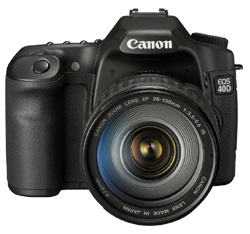
Approx. dates of manufacture: 2008
Sensor Size: CMOS APS-C
Max Resolution: 3888 x 2592
Memory card: Compact Flash (CF)
Battery:: BP-511A
Approx. original price: $1,500
Approx. street value: $400 (varies widely)
As I write this, Canon makes four tiers of digial SLRs: the EOS-1D line is the top, super-professional camera. The 5D is the 35mm sensor-size format pro, the 40D (they just came out with the 50D) is the APS-C size sensor for advanced amateurs or light-duty pros, and the Rebels (aka the 300/350/400D series) are the entry-level, APS-C size amateurs.
This is the best one I could afford: the next step up (the 5D) was almost double the price for the body alone, and all you got for the money is older technology and a somewhat larger sensor. The full-frame sensor size, at least for my purposes, would be nice because the lens focal lengths would match 35mm views, but not for that price. Maybe in 10 years.
The smaller sensor size changes the angles of view on 35mm lenses. In other words, a 50mm lens on a 35mm film camera gives you about 46° of view, which is "normal" in terms of what you normally see without a camera, binoculars, etc. But on a smaller sensor, the view is narrower by a factor (in Canons) of around 1.6. So a 50mm lens on this 40D mimics an 80mm on a film or full-size-sensor camera. A 200mm lens acts like a 300mm, and so on. That's great for long lenses, but bad if you like wide-angles.
I'm still getting used to it, and it's complicated as hell so I'm still consulting the book on how to do a lot of functions, like exposure compensation. But it's complicated because it does a ton of stuff. It has multiple AF zones, and you can let the camera decide which zones it thinks should be used, or you can choose which zone to use. It has mutliple metering patterns, full manual, several full-auto modes, and a number of semi-auto exposure modes. I still haven't figured out the predictive focus or switching between single and burst shots. If/when I get the proper flash for it, that'll open a door for a whole new range of things.
One of the beauties of this is that it's evolutionary; it shares a lot of basic features and layout with my earlier EOS-1 film cameras, which in turn flows from the T90; you don't have to start from square one to learn how the controls work, and you can go back and forth between them with some feeling of consistency.
One thing I really like is that it doesn't have a lot of accessories, since so many things are already built in. There's no high-speed autowinder because there's no film to wind, and it already has a fast multi-shot capability incorporated into it. There's no "data back" or "command back" because most of the features are already there. I could buy the add-on battery pack, and there's a nifty WiFi base for it that I'd love to have but it's too damned expensive.
Camera manual: Orphan Cameras.com



